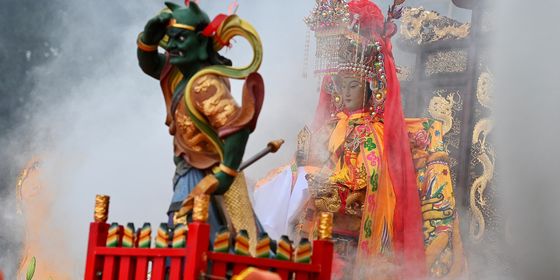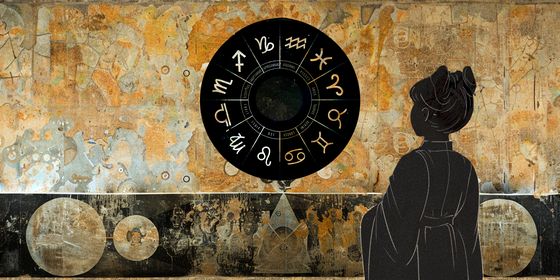In 18th century China, evil spirits and sorcerers were a constant menace to the public and the government
A father and son hurry down a dark, dusty road, scanning ahead for the light of an inn or place to rest. Roads in 18th century China can be dangerous, and desperate men prey upon the weak and unwary. Yet even the bandits seek shelter indoors when night falls, for some things that lurk in the shadows are deadlier than any brigand or cutthroat.
Recorded folk tales and local legends from the Qing era reveal a world of fox spirits, malevolent demons, wandering ghosts, sorcerers, and soul stealers. Even the official records maintained by supposedly sober-minded Confucian scholar-officials feature numerous reports detailing supernatural encounters and otherworldly phenomena.
In China, the seventh month of the lunar calendar is Ghost Month, a time of the year when the spirits of the deceased are most active. As with the North Atlantic tradition of Halloween, Ghost Month is a time when thoughts turn spooky, and in China there is a long history of spirits interacting with the living.
In his Strange Tales from a Chinese Studio (《聊斋志异》), Qing-era writer and folklorist Pu Songling (蒲松龄) collected and curated a set of ghastly, macabre, and grotesque tales which continue to frighten and astonish, both on the page and onscreen. In these stories, young scholars fall victim to demons dressed in human skin, merchants are the prey of lascivious but lethal spirits, and ghosts haunt the lives of the unjust, the wicked, or the plain unlucky.
Fox spirits, who could change from human to animal form at will, were considered as much a part of the terrain as roads, walls, gates, and bridges. In the Pu Songling story “Hu Dagu (《胡大骨》),” a family in Shandong province is terrorized after unwittingly allowing a malevolent fox spirit to join their ranks. Other tales tell of fox spirits appearing in the guise of beautiful women waiting to seduce lustful travelers and lead them to their doom.
Sections of cities, particularly those with spooky or abandoned structures, became known haunts, even in the capital. The “Fox Tower” sits along the eastern edge of the old Beijing city wall and once overlooked a desolate area where a fetid canal cut through a garbage-strewn wasteland. Fear of fox spirits kept many residents away, and the tower’s reputation grew even more sinister after the mutilated body of Pamela Werner, the subject of the bestseller Midnight in Peking by Paul French, was found by an elderly man walking his birds on a cold winter morning in 1937.

A 19th century illustration of the Hu Dagu story in Pu Songling’s “Strange Tales from a Chinese Studio” (Wikimedia Commons)
Fears of the supernatural could even penetrate the inner realms of the Forbidden City. Historian Philip Kuhn’s masterful 1990 study Soulstealers: The Chinese Sorcery Scare of 1768 begins with a group of unfortunate stoneworkers suspected of employing sorcery to repair a bridge near Suzhou in today’s Jiangsu province. A short while later, a band of wandering monks is arrested and tortured, accused of clipping “queues,” the braids worn by Chinese men as a sign of submission to Qing imperial rule. Local officials charged the monks with using the locks of hair for witchcraft. The sorcery scare spread to other cities and up the chain of command, eventually reaching the desk of the Qianlong Emperor. The emperor, awash in his own anxieties of political dissent and the growing shadow of corruption, took a personal interest in crushing the outbreak of queue-cutting soul stealers.
As with the witch trials in Europe and North America in the 16th and 17th centuries and modern-day sorcery scares which periodically break out in South Asia and parts of West Africa, soul stealing hysteria in China occurred at times already fraught with social anxiety due to an unstable economy, an influx of migrants from other parts of the empire, a sudden crime wave or rash of kidnappings, or a natural disaster like floods, droughts, or epidemics. Cultural misunderstandings could lead to accusations of witchcraft: often, those groups targeted by witch hunts and sorcery scares were marginal populations; migrants, monks, beggars, widows, and recent arrivals to a region or city.
Foreign missionaries could get caught up in Chinese sorcery and shamanism. One evening in 1863, a woman brought her daughter to a clinic run by foreign nuns in the port city of Tianjin. The girl was in the throes of an evil curse, and the nuns declared it a case of spiritual warfare. The sisters restrained the girl with ropes and summoned a French priest to carry out the exorcism. Demonic possession was one area where Catholic missionary practice intersected with Chinese popular beliefs. For days, the priest battled the demon for the young girl’s soul before the missionaries declared victory. Unfortunately, what the priest and nuns took to demonstrate the might of the Christian God and the power of their faith, was understood by their neighbors as proof that the foreigners practiced a powerful—and possibly malignant—form of magic.
As with modern horror movies, such tales not only titillate but also reveal the otherwise unspoken anxieties and unspeakable taboos that lay beneath society’s surface. As fantastic—and morbid—as these stories can be, they are valuable resources. The sexual, sometimes pornographic, nature of some of these folktales no doubt made them popular when told around a warm fire in the safety of a roadside inn. Violent tales of hair, eyes, hearts, and other more delicate organs being stolen or removed from the unwary shocked listeners but also revealed how fears of spirit possession or curses overlapped with anxieties about the body and bodily mutilation.
The people of 18th century China lived in a different world than we do today, one where supernatural forces were a real and present part of the landscape. Yet hysteria, the spread of misinformation, and the irrational fear of outsiders are hardly unique to the Qing dynasty. Ghost stories, ghastly tales, myths, and legends continue to guide those looking at the past and seeking to understand our societies today.












